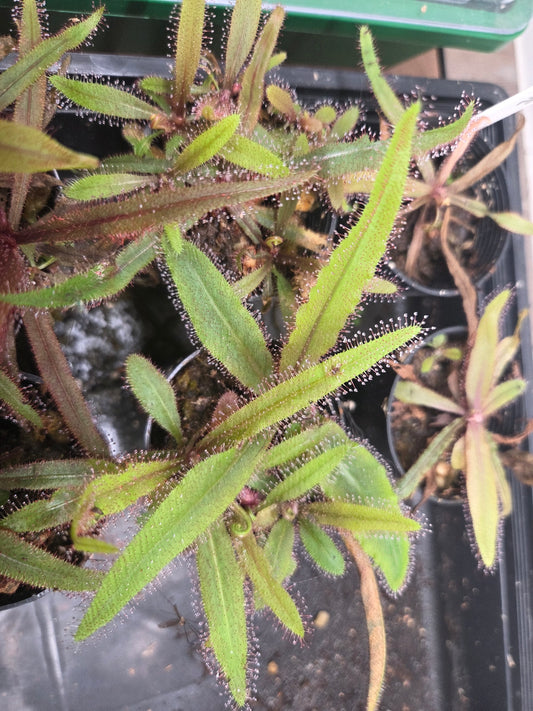Collection: Drosera (Sundews)
Drosera, which is commonly known as the sundews, is one of the largest genera of carnivorous plants, with at least 194 species. These plants lure, capture, and digest insects using stalked mucilaginous glands covering their leaf surfaces. This behaviour helps supplement the poor mineral nutrition of the soil in which the plants grow. Various species, which vary greatly in size and form, are native to all over the world.
Generalised Growing Care for Drosera (Please do further research on particular species or hybrids.)
Please not this guide does not include relevant information on tuberous drosera, which have vastly different requirements then what is listed.
Sunlight: Direct sunlight during the less intense parts of the day (early morning and late afternoon) or indirect bright light. Some Drosera can tolerate full sun, however I would be cautious during the intense summer heat. A shadecloth of 50% can help take out the intensity. If Drosera don't recieve adequate light, they will produce little to no dew. 'QLD's Three Sisters' (D. adelae, D. prolifera and D. schizandra) require less light then what is typically required and can grow well in full shade.
Temperature: Generally, most Dorsera have quite a wide tolerance to temperature. In my experience, lows of 10 degrees and highs of 35 degrees are tolerated. The exception to this is 'QLD's Three Sisters' where they appear to need temperatures to remain above 15 degrees to grow best as they are native to the tropics.
Watering: Drosera like to be moist and can sit in water for extended periods of time (within reason). Rainwater is highly recommended or filtered water as tap water can contain harsh salts and minerals that can kill Drosera. Using a pot saucer or tray can be a handy way to keep the pot damp consistently. Never let the soil dry out, especially during the warmer months of the year.
Humidity: Recommended humidity range for Drosera is between 50% - 80%, anything lower and the plant may stop producing dew (some easy growing species such as D. capensis can tolerate lower humidity). If humidity is kept above 90% consistently, it is crucial there is adequate air flow or fungal and viral infections can arise. 'QLD's Three Sisters' Drosera require humidity to be on the higher side consistently to grow best.
Media: I grow most of my Drosera in either 1:1 ratio of peat moss and perlite or a 1:1 peat moss and sand. Perlite or sand is important as it allows the media to breathe and drain when wet and reduces the risk of root rot. For 'QLD's Three Sisters', I recommend either pure sphagnum moss or some added perlite as a mix. Other mixes also work fine.
Dormancy: Most Drosera do not go dormant (there are exceptions!) but will slow down during periods of cooler temperatures and shorter days.
-
Drosera adelae
Regular price $15.00 AUDRegular price
